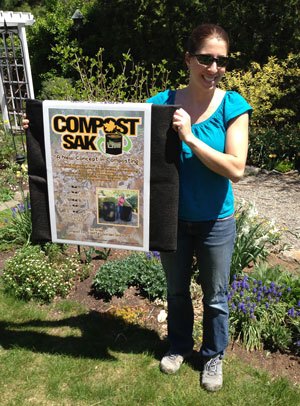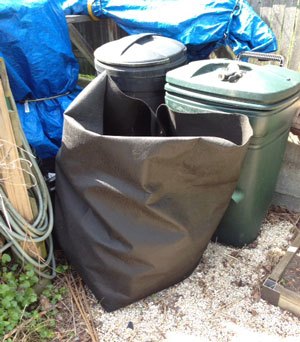

The Compost Sak comes neatly packaged in a cardboard sleeve printed with lots of useful information about composting.
The Compost Sak is made by the same folks who brought us Smart Pots, those reusable, fabric pots that can be used to grow just about anything. It’s a large, fabric bag that comes neatly folded in a cardboard sleeve. The packaging is printed with a lot of great information about composting so don’t forget to read it before setting up your new Compost Sak.
Simple to Set Up
Simply remove the cardboard packaging, open the Compost Sak, and you’re ready to go. Really. It couldn’t be any easier. Not convinced? Just watch the video.
Lightweight
Because it’s made out of a porous, geo-textile fabric, the Compost Sak weighs next to nothing – when it’s empty. That makes it easy to move into the perfect position before you start filling it. But when it’s full, don’t plan on moving it! Finished compost, as well as the raw materials that go into making it, weighs a lot – particularly when it’s wet.
Easy to Fill
One of the keys to successful composting is to fill your compost bin with the right mix of brown (dried or dead material) and green (live plant material or food scraps). See our Resource page on composting for more details. With the Compost Sak, you simply toss in material and that’s it. While the sides can be a little floppy when the Sak is empty, they stand up well enough not to get in the way. And with the wide opening, you can throw in longer or larger pieces than you could in many other commercially-available composting bins. Of course, shredding material first will speed up the composting process.
Good Size for Composting
3’x3’ is the minimum recommended size for a compost bin. This allows compost to heat up enough to form compost within a reasonable period of time. The Compost Sak is 30” wide (it’s round) and 38” tall. The manufacturer says that it can make up to 15 cubic feet of finished compost (if the Sak was filled to the top) and can hold over 100 gallons. Many of the plastic composters you’ll find in catalogs and garden centers are considerably smaller.
Aerates Compost
Good aeration is necessary for composting. Without it, you’ll end up with a slimy, stinky mess. Usually, this is accomplished by turning your pile of compost regularly to get oxygen into the center of the pile. While it would still be helpful to turn (or at least stir) the contents of the Compost Sak from time to time, the breathable fabric allows air to more easily penetrate the pile without a lot of extra work. The fabric also allows moisture to both enter and exit the pile, as needed.
Durable
You might wonder how long a fabric compost bin would last. The manufacturer has a 1 year warrantee on the Compost Sak but I would expect it to last much longer than that. It’s made out of the same material as the Smart Pots; I’ve been using my Smart Pots for 5 years now and they still look like new. Editor’s Note: One year after this review was originally written, the Compost Sak is still going strong. The organic material in the Sak has decomposed to usable compost and the fabric still looks almost like new.

The Compost Sak is large and easy to fill. This photo shows it just over half full.
Turning the Compost
The manufacturer recommends turning the compost regularly to speed decomposition, but I think the Compost Sak is best used as a supplemental composter where you can fill it and forget it. Expect compost in about a year. Alternatively, you could use the end of a rake or broom to poke and stir the contents, or use a Compost Aerator (a tool with ‘wings’ that stick out when you pull the tool out of the pile, allowing air into the compost). Don’t even think about trying to turn the contents with a shovel or garden fork; you’ll just end up tearing holes in the fabric.
Placing the Compost Sak
The Sak doesn’t have a flat bottom and so it’s hard to keep it standing upright, even when it’s full. You may want to place it in a corner where it’s well supported, or use rebar/stakes to keep it in place. Be sure to place it in a location where it will get at least 6 hours of sun each day; compost will develop more quickly in a sunny spot. And don’t plan on moving it when it’s full, so place it in a location where you can leave it for the long term.
Recommendation
 The Compost Sak gets our 4 Shovels rating. We marked it down mostly because of the difficulty in keeping it upright when fully loaded. Depending on where you put the Compost Sak, this may not be an issue for you.
The Compost Sak gets our 4 Shovels rating. We marked it down mostly because of the difficulty in keeping it upright when fully loaded. Depending on where you put the Compost Sak, this may not be an issue for you.
Where to Buy the Compost Sak
The Sak is available at a variety of garden centers and some national retailers (there’s no list on the website so check with individual stores before you go). You can also buy it directly from the manufacturer through their website, as well as from Amazon (affiliate link). At only $39.95 (plus shipping), it’s well priced; in fact, you may want to buy two so that as one pile is finishing, you can start a second one.
And now over to you – Which composters have you used? What did you like or not like about them? Let us know in the comments below.
SOURCE:http://gardeningproductsreview.com/compost-sak-product-review/